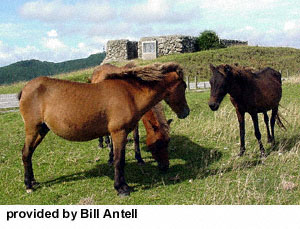
Yonaguni

Introduction: If you have any comments or suggestions, please click here.
Names: Yonaguni. Called both a horse and a pony; it is listed under pony due to size.
Origin: The
Yonaguni is a small native pony of the southwest islands of Japan. In 1996 there
were about seventy-five living Yonaguni ponies on East and North Ranches on
Yonaguni Island, located on the west side of the Yaeyama Islands.
Little is known about the origin of the Yonaguni. Horses in
Japan can generally be divided into two groups, larger specimens from Hokkaido
and smaller individuals from Yonaguni. Many people believe that the small horses
were introduced from the southern islands during the Jyomon Period, about two
thousand years ago. Professor Ken Nozawa of Kyoto University claimed in 1983
that the gene characteristcs of the breed indicated relationship to the Cheju
breed in Korea.
Breeding: In the old days every household had one horse or more for transportation and plowing. In 1939, when local breeds began to be improved to produce larger war horses, the Yonaguni on their remote island were excluded from that plan, and the original breed has been preserved. As technology has improve, horses have become less important and the population of all horse breeds in Japan has been drastically reduced. Once of great importance in the daily lives of the islanders, today the Yonaguni may be seen on only a few ranches and has become a precious cultural asset. Their population status is rare.
Description:
Back: Long.
Color: The Yonaguni are usually chestnut.
Croup: Often quite level with a high tail-set.
Head: Large with well-placed eyes and relatively small ears.
Hooves: Vertically long and very hard.
Legs: Often tend to be splayed.
Neck: Short and thick.
Quarters: Slight.
Shoulders: Tend to be straight.
Temperament: This pony is gentle in nature.
Features: Very strong and enduring.
Uses:
Accomplishments:
Curiosities:
Profiles:
Conclusion: